Model Mediation to Overcome Light Limitations—Toward a Secure Tactile Internet System
Abstract
1. Introduction
- (a)
- Healthcare applications:Tactile Internet is expected to assist the human healthcare by introducing new applications and facilities that do not support by the traditional networks. These applications include remote rehabilitation, remote diagnosis, and remote surgery applications. These applications will make the rare medical expertise and physicians available anywhere, and break the location limitations. Furthermore, robots can perform complete complicated surgeries (e.g., neurological surgery and heart surgery) with a remote control by an expert surgeon over the tactile Internet [19].
- (b)
- Virtual and augmented reality (VR/AR) applications:Tactile Internet will assist the dynamic augmentation instead of existing static solutions. VR can be considered as a form of haptic communications that will be delivered more collaboratively over the tactile Internet. Complete latency and reliability requirements of the VR/AR applications will be supported by the tactile Internet, which is expected to achieve a round trip latency of 1 ms far from that required by VR applications (i.e., 5 ms) [20].
- (c)
- Industry automation applications:The closed loop control circuit of most of industry automated systems requires a per sensor end-to-end latency of 1 ms [17,21]. This can be achieved via the tactile Internet system and the current wired system would be turned to wireless or augmented systems. This will enable more automated process and enhance the automation of current processes.
- (d)
- Robotics applications:Recently, robots have begun to take part in our daily life, and the number of developed robots and their market revenue increase daily [22]. Tactile Internet will take part in the human controlled robots; especially for remote control applications. The ultra-reliable latency and reliability required by remote controlled robots will be achieved by the tactile Internet [23].
- (e)
- Vehicular applications:Tactile Internet is expected to assist the road traffic management through the vehicle sensors and driver assistance systems. Tactile Internet will facilitate and provide the medium for the vehicle to vehicle communication (V2V) and the vehicle to the road side infrastructure communication (V2I). Furthermore, the high mobility required by the vehicular applications will be supported by the tactile Internet [24].
- (f)
- Smart grid applications:The main aim of the intelligent smart grid is to distribute the generated energy efficiently, with the required stability of power supply. The intelligent smart grid systems monitor the status of the power generators and transmission lines, and control the operation of both. Furthermore, the user consumptions and tariffs are monitored and controlled by the intelligent grid systems. Thus, such systems require ultra-reliability and low latency communication systems (e.g., the required end-to-end latency of a synchronous co-phasing of power suppliers is 1 ms) to convey the information among the network. Tactile Internet will support these systems by achieving an end-to-end latency of 1 ms with an ultra-high reliability (e.g., systems with packet loss probability of 0.001%) [25].
- (g)
- Other applications:Tactile Internet will have many applications in various fields, which are not limited to the previous mentioned ones. Tactile Internet is expected to have applications in other vital fields such as education, culture, serious gaming, and unmanned aerial vehicles. Tactile Internet will assist developing applications that will help children as well as adults with difficulties in developing their education skills, recovery of skills after injury or having disabilities [17,26].
- a-
- Latency:Tactile Internet is announced as an ultra-reliable low latency (uRLL) use case of the fifth-generation cellular system (5G/IMT2020) [31,32]. Tactile Internet system requires an end-to-end latency of 1 ms, which is far from the end-to-end latency of current applications and systems. Latest systems of fourth-generation cellular system (4G) handle a round trip latency of 15 ms, while the first release of 5G is expected to enhance the latency performance and achieve an end-to-end latency of 5 ms [33]. Tactile Internet will reduce this latency to 1 ms that will include all delays involved in the communication process. Section 3 discusses the 1 ms challenge in details.
- b-
- Reliability:Tactile Internet system is required to achieve ultra-high reliability so that the packet loss will be less than 10−7 [34]. This is because higher packet loss probability, results in incorrect data at the slave side that leads to incorrect interaction with the remote side [35]. Current transmission protocols (e.g., UDP and TCP) cannot be used for the tactile Internet applications, especially for haptic based applications, because of the required reliability and latency. Thus, new protocols need to be developed.
- c-
- Security:Heterogeneous communications over the tactile Internet requires different levels of security. The internet protocol security (IPSec) represents a sufficient framework for security issues associated with most of traditional communication applications, while for haptic communication applications and other applications (e.g., augmented reality (AR) and virtual reality (VR)), new security frameworks should be introduced since existing frameworks cannot be used [36,37]. This is because the implementations of current security methods for these systems affect the communication latency constraints by introducing much delay. Thus, security issues and the required security levels of tactile Internet applications should be considered for each kind or group of applications with the consideration of end-to-end latency constraints required by the system to achieve acceptable level of user experience [38].
2. Haptic Communications
3. One Millisecond Challenge
4. Model Mediation
4.1. Environmental Modeling
4.2. Model Mediated Systems
4.2.1. Early Birds
4.2.2. Common Systems
4.2.3. Recent Systems
4.3. Challenges
- 1-
- Transparency: is a measure of fidelity. It measures the degree of sense that the master device feel when interacting with a remote environment [84]. For a high transparency, the virtual model should provide the physical properties of the environment with no distortions. The degree of matching between the actual environment physical parameters and that of the virtual environment is a measure of the transparency [85].
- 2-
- Stability: is an important parameter that must be considered when designing a model mediated system. The stability of haptic rendering must be ensured for haptic communication systems especially for long distance communication [86]. The main reason affecting the stability of the model mediated systems is the force disturbance. As the hardware on either side may be affected—or worse, damaged—when fed with an excessive force or a vibrating one [87].
- 3-
- Consistency: this property insures that all users share the same virtual environment have the same experience. This property is considered only for a system with distributed users in either one side. The consistency is mainly affected by the delay between user and the virtual environment [88].
5. Security Issues
6. Tactile Internet System with AI Model Mediated
Stability vs. Communication Delay
7. Conclusions
Author Contributions
Funding
Conflicts of Interest
References
- Dohler, M.; Fettweis, G. The Tactile Internet—IoT, 5G and Cloud on Steroids. In Proceedings of the 5G Radio Technology Seminar. Exploring Technical Challenges in the Emerging 5G Ecosystem, London, UK, 17 March 2015; pp. 1–16. [Google Scholar]
- Maier, M.; Chowdhury, M.; Rimal, B.P.; Van, D.P. The tactile internet: Vision, recent progress, and open challenges. IEEE Commun. Mag. 2016, 54, 138–145. [Google Scholar] [CrossRef]
- Aijaz, A. Towards 5G-enabled tactile internet: Radio resource allocation for haptic communications. In Proceedings of the 2016 IEEE Wireless Communications and Networking Conference (WCNC), Doha, Qatar, 3–6 April 2016; pp. 1–6. [Google Scholar]
- Aijaz, A.; Dohler, M.; Aghvami, A.H.; Friderikos, V.; Frodigh, M. Realizing the Tactile Internet: Haptic Communications over Next Generation 5G Cellular Networks. IEEE Wirel. Commun. 2017, 24, 82–89. [Google Scholar] [CrossRef]
- Aijaz, A.; Dawy, Z.; Pappas, N.; Simsek, M.; Oteafy, S.; Holland, O. Toward a Tactile Internet Reference Architecture: Vision and Progress of the IEEE P1918. 1 Standard. arXiv, 2018; arXiv:1807.11915. [Google Scholar]
- Vulliez, M.; Zeghloul, S.; Khatib, O. Design strategy and issues of the Delthaptic, a new 6-DOF parallel haptic device. Mech. Mach. Theory 2018, 128, 395–411. [Google Scholar] [CrossRef]
- Chizeck, H.J.; Ryden, F.; Stewart, A. Methods and Systems for Six-Degree-of-Freedom Haptic Interaction with Streaming Point Data. U.S. Patent No. 9,753,542, 5 September 2017. [Google Scholar]
- Chan, L.; Naghdy, F.; Stirling, D. Application of adaptive controllers in teleoperation systems: A survey. IEEE Trans. Hum.-Mach. Syst. 2014, 44, 337–352. [Google Scholar]
- Nakamura, N.; Fukui, Y.; Sakai, M.; Koda, N.; Iizuka, Y. Haptic Information Presentation System and Method. U.S. Patent Application No. 15/285, 3 August 2017. [Google Scholar]
- Steinbach, E.; Strese, M.; Eid, M.; Liu, X.; Bhardwaj, A.; Liu, Q.; Al-Ja’afreh, M.; Mahmoodi, T.; Hassen, R.; El Saddik, A.; Holland, O. Haptic Codecs for the Tactile Internet [40pt]. Proc. IEEE 2018, 1–24. [Google Scholar] [CrossRef]
- Touch. Available online: https://www.3dsystems.com/haptics-devices/touch (accessed on 5 October 2018).
- Geomagic Touch. Available online: https://bigsys.com/site/product/geomagic-touch/ (accessed on 5 October 2018).
- Phantom Premium. Available online: https://www.3dsystems.com/haptics-devices/3d-systems-phantom -premium (accessed on 7 October 2018).
- Virtuose 6d. Available online: https://www.haption.com/en/products-en/virtuose-6d-en.html#fa-th-large -applications (accessed on 7 October 2018).
- Omega.7. Available online: http://www.forcedimension.com/products/omega-7/overview (accessed on 5 October 2018).
- Sigma-7. Available online: http://www.forcedimension.com/products/sigma-7/overview (accessed on 7 October 2018).
- ITU-T Technology Watch Report—The Tactile Internet; International Telecommunication Union: Paris, France, 2014.
- Sachs, J.; Andersson, L.A.; Araújo, J.; Curescu, C.; Lundsjö, J.; Rune, G.; Steinbach, E.; Wikström, G. Adaptive 5G Low-Latency Communication for Tactile Internet Services. Proc. IEEE 2018, 1–25. [Google Scholar] [CrossRef]
- Miao, Y.; Jiang, Y.; Peng, L.; Hossain, M.S.; Muhammad, G. Telesurgery Robot Based on 5G Tactile Internet. Mob. Netw. Appl. 2018, 23, 1645–1654. [Google Scholar] [CrossRef]
- Elbamby, M.S.; Perfecto, C.; Bennis, M.; Doppler, K. Toward Low-Latency and Ultra-Reliable Virtual Reality. IEEE Netw. 2018, 32, 78–84. [Google Scholar] [CrossRef]
- Wollschlaeger, M.; Sauter, T.; Jasperneite, J. The future of industrial communication: Automation networks in the era of the internet of things and industry 4.0. IEEE Ind. Electron. Mag. 2017, 11, 17–27. [Google Scholar] [CrossRef]
- Kaboli, M.; Yao, K.; Feng, D.; Cheng, G. Tactile-based active object discrimination and target object search in an unknown workspace. Auton. Robots 2018, 1–30. [Google Scholar] [CrossRef]
- Romano, J.M.; Hsiao, K.; Niemeyer, G.; Chitta, S.; Kuchenbecker, K.J. Human-inspired robotic grasp control with tactile sensing. IEEE Trans. Robot. 2011, 27, 1067–1079. [Google Scholar] [CrossRef]
- Dressler, F.; Klingler, F.; Segata, M.; Cigno, R.L. Cooperative Driving and the Tactile Internet. Proc. IEEE 2018, 1–11. [Google Scholar] [CrossRef]
- Chang, B.; Zhao, G.; Imran, M.A.; Li, L.; Chen, Z. Dynamic QoS allocation for real-time wireless control in tactile internet. In Proceedings of the 2018 IEEE 5G World Forum (5GWF), Silicon Valley, CA, USA, 9–11 July 2018; pp. 273–277. [Google Scholar]
- Maier, M.; Ebrahimzadeh, A.; Chowdhury, M. The Tactile Internet: Automation or Augmentation of the Human? IEEE Access 2018, 6, 41607–41618. [Google Scholar] [CrossRef]
- Aijaz, A.; Simsek, M.; Dohler, M.; Fettweis, G. Shaping 5G for the tactile internet. In 5G Mobile Communications; Springer International Publishing: Cham, Switzerland, 2017; pp. 677–691. [Google Scholar]
- D’Ursol, F.; Grasso, C.; Santoro, C.; Santoro, F.F.; Schembra, G. The Tactile Internet for the flight control of UAV flocks. In Proceedings of the 2018 4th IEEE Conference on Network Softwarization and Workshops (NetSoft), Montreal, QC, Canada, 25–29 June 2018; pp. 470–475. [Google Scholar]
- Ateya, A.A.; Muthanna, A.; Gudkova, I.; Vybornova, A.; Koucheryavy, A. Intelligent core network for Tactile Internet system. In Proceedings of the ACM International Conference on Future Networks and Distributed Systems, Cambridge, UK, 19–20 July 2017; p. 15. [Google Scholar]
- Fettweis, G.P. The tactile internet: Applications and challenges. IEEE Veh. Technol. Mag. 2014, 9, 64–70. [Google Scholar] [CrossRef]
- Recommendation ITU-R M.2083: IMT Vision. Framework and Overall Objectives of the Future Development of IMT for 2020 and Beyond; International Telecommunication Union: Geneva, Switzerland, 2015.
- 3GPP TR 38.913. Study on Scenarios and Requirements for Next Generation Access Technologies. Ver. 14.3.0. Available online: https://portal.3gpp.org/desktopmodules/Specifications/SpecificationDetails.aspx? specificationId=2996 (accessed on 17 October 2018).
- Ateya, A.; Al-Bahri, M.; Muthanna, A.; Koucheryavy, A. End-to-end system structure for latency sensitive applications of 5G. Элeктpocвязь 2018, 6, 56–61. [Google Scholar]
- Farhoudi, M.; Palantas, P.; Abrishamchi, B.; Mihailovic, A.; Aghvami, A.H. A novel reliable routing scheme for Tactile-oriented Internet traffic. In Proceedings of the IEEE 2017 24th International Conference on Telecommunications (ICT), Limassol, Cyprus, 3–5 May 2017; pp. 1–7. [Google Scholar]
- Van Den Berg, D.; Glans, R.; De Koning, D.; Kuipers, F.A.; Lugtenburg, J.; Polachan, K.; Venkata, P.T.; Singh, C.; Turkovic, B.; Van Wijk, B. Challenges in Haptic Communications Over the Tactile Internet. IEEE Access 2017, 5, 23502–23518. [Google Scholar] [CrossRef]
- Zenger, C.T.; Zimmer, J.; Pietersz, M.; Driessen, B.; Paar, C. Constructive and destructive aspects of adaptive wormholes for the 5g tactile internet. In Proceedings of the 9th ACM Conference on Security & Privacy in Wireless and Mobile Networks, Darmstadt, Germany, 18–20 July 2016; pp. 109–120. [Google Scholar]
- Antonakoglou, K.; Xu, X.; Steinbach, E.; Mahmoodi, T.; Dohler, M. Towards haptic communications over the 5G tactile Internet. IEEE Commun. Surv. Tutor. 2018, 20, 3034–3059. [Google Scholar] [CrossRef]
- Wong, E.; Dias, M.P.I.; Ruan, L. Predictive resource allocation for Tactile Internet capable passive optical LANs. J. Light. Technol. 2017, 35, 2629–2641. [Google Scholar] [CrossRef]
- Schneider, O.; MacLean, K.; Swindells, C.; Booth, K. Haptic experience design: What hapticians do and where they need help. Int. J. Hum.-Comput. Stud. 2017, 107, 5–21. [Google Scholar] [CrossRef]
- Simsek, M.; Aijaz, A.; Dohler, M.; Sachs, J.; Fettweis, G. 5G-enabled tactile internet. IEEE J. Sel. Areas Commun. 2016, 34, 460–473. [Google Scholar] [CrossRef]
- Ateya, A.A.; Vybornova, A.; Kirichek, R.; Koucheryavy, A. Multilevel cloud based Tactile Internet system. In Proceedings of the IEEE 19th International Conference on Advanced Communication Technology (ICACT), Bongpyeong, Korea, 19–22 February 2017; pp. 105–110. [Google Scholar]
- Lema, M.A.; Antonakoglou, K.; Sardis, F.; Sornkarn, N.; Condoluci, M.; Mahmoodi, T.; Dohler, M. 5G case study of Internet of Skills: Slicing the human senses. In Proceedings of the IEEE 2017 European Conference on Networks and Communications (EuCNC), Oulu, Finland, 12–15 June 2017; pp. 1–6. [Google Scholar]
- Stevens, S.S. Psychophysics: Introduction to Its Perceptual, Neural and Social Prospects; Routledge: Abington, UK, 2017. [Google Scholar]
- Foxlin, X.; Hayes, T. Haptic Communication Device and System for Transmitting Haptic Interaction. U.S. Patent Application No. 15/393,782, 6 July 2017. [Google Scholar]
- Okamura, A.M. Haptic Dimensions of Human-Robot Interaction. ACM Trans. Hum.-Robot Interact. (THRI) 2018, 7, 6. [Google Scholar]
- Suzuki, A.; Ohnishi, K. Novel four-channel bilateral control design for haptic communication under time delay based on modal space analysis. IEEE Trans. Control Syst. Technol. 2013, 21, 882–890. [Google Scholar] [CrossRef]
- You, J.; Reiter, U.; Hannuksela, M.M.; Gabbouj, M.; Perkis, A. Perceptual-based quality assessment for audio–visual services: A survey. Signal Process. Image Commun. 2010, 25, 482–501. [Google Scholar] [CrossRef]
- Kinnebrew, P.T.; Kamuda, N.F. Configured Virtual Environments. U.S. Patent No. 9,645,394, 9 May 2017. [Google Scholar]
- Pai, D.K.; Rothwell, A.; Wyder-Hodge, P.; Wick, A.; Fan, Y.; Larionov, E.; Harrison, D.; Neog, D.R.; Shing, C. The human touch: Measuring contact with real human soft tissues. ACM Trans. Graph. (TOG) 2018, 37, 58. [Google Scholar] [CrossRef]
- 3GPP TS 28.554. Management and Orchestration; 5G End to End Key Performance Indicators (KPI). Ver. 2.0.0, Release 15. 2018. Available online: https://portal.3gpp.org/desktopmodules/Specifications/SpecificationDetails.aspx?specificationId=3415 (accessed on 20 October 2018).
- Ateya, A.A.; Muthanna, A.; Gudkova, I.; Abuarqoub, A.; Vybornova, A.; Koucheryavy, A. Development of Intelligent Core Network for Tactile Internet and Future Smart Systems. J. Sens. Actuator Netw. 2018, 7, 1. [Google Scholar] [CrossRef]
- Höyhtyä, M.; Apilo, O.; Lasanen, M. Review of Latest Advances in 3GPP Standardization: D2D Communication in 5G Systems and Its Energy Consumption Models. Future Internet 2018, 10, 3. [Google Scholar] [CrossRef]
- Satyanarayanan, M. The Emergence of Edge Computing. Computer 2017, 50, 30–39. [Google Scholar] [CrossRef]
- Dohler, M.; Mahmoodi, T.; Lema, M.A.; Condoluci, M.; Sardis, F.; Antonakoglou, K.; Aghvami, H. Internet of Skills, where Robotics meets AI, 5G and the Tactile Internet. In Proceedings of the IEEE 2017 European Conference on Networks and Communications (EuCNC), Oulu, Finland, 12–15 June 2017; pp. 1–5. [Google Scholar]
- Hua, C.C.; Yang, X.; Yan, J.; Guan, X.P. On exploring the domain of attraction for bilateral teleoperator subject to interval delay and saturated P+ d control scheme. IEEE Trans. Autom. Control 2017, 62, 2923–2928. [Google Scholar] [CrossRef]
- Ghavifekr, A.A.; Ghiasi, A.R.; Badamchizadeh, M.A. Discrete-time control of bilateral teleoperation systems: A review. Robotica 2018, 36, 552–569. [Google Scholar] [CrossRef]
- Condoluci, M.; Mahmoodi, T.; Steinbach, E.; Dohler, M. Soft resource reservation for low-delayed teleoperation over mobile networks. IEEE Access 2017, 5, 10445–10455. [Google Scholar] [CrossRef]
- Xu, X.; Cizmeci, B.; Schuwerk, C.; Steinbach, E. Model-mediated teleoperation: Toward stable and transparent teleoperation systems. IEEE Access 2016, 4, 425–449. [Google Scholar] [CrossRef]
- Yilmaz, O.N.; Wang, Y.P.E.; Johansson, N.A.; Brahmi, N.; Ashraf, S.A.; Sachs, J. Analysis of ultra-reliable and low-latency 5G communication for a factory automation use case. In Proceedings of the 2015 IEEE International Conference on Communication Workshop (ICCW), London, UK, 8–12 June 2015; pp. 1190–1195. [Google Scholar]
- Riedel, M.; Franchi, A.; Giordano, P.R.; Bülthoff, H.H.; Son, H., II. Experiments on Intercontinental Haptic Control of Multiple UAVs. In Intelligent Autonomous Systems 12; Lee, S., Cho, H., Yoon, K.J., Lee, J., Eds.; Springer: Berlin/Heidelberg, Germany, 2018; Volume 19, pp. 57–68. [Google Scholar]
- Mohammadi, L.; Alfi, A.; Xu, B. Robust bilateral control for state convergence in uncertain teleoperation systems with time-varying delay: A guaranteed cost control design. Nonlinear Dyn. 2017, 88, 1413–1426. [Google Scholar] [CrossRef]
- Zhao, Z.; Yang, J.; Liu, C.; Chen, W.H. Nonlinear composite bilateral control framework for n-DOF teleoperation systems with disturbances. Sci. China Inf. Sci. 2018, 61, 70221. [Google Scholar] [CrossRef]
- Shahbazi, M.; Atashzar, S.F.; Patel, R. A Systematic Review of Multilateral Teleoperation Systems. IEEE Trans. Haptics 2018. [Google Scholar] [CrossRef] [PubMed]
- Holmes, K.G.; Coates, A.; Hammoudeh, M. Motion Capture Using the Internet of Things Technology: A Tutorial. In Proceedings of the ACM International Conference on Future Networks and Distributed Systems, Cambridge, UK, 19–20 July 2017; p. 40. [Google Scholar]
- Xia, P. New advances for haptic rendering: State of the art. Vis. Comput. 2018, 34, 271–287. [Google Scholar] [CrossRef]
- Garrido, J.; Vázquez, F.; Morilla, F.; Normey-Rico, J.E. Smith predictor with inverted decoupling for square multivariable time delay systems. Int. J. Syst. Sci. 2016, 47, 374–388. [Google Scholar] [CrossRef]
- Bejczy, A.K.; Kim, W.S.; Venema, S.C. The phantom robot: Predictive displays for teleoperation with time delay. In Proceedings of the 1990 IEEE International Conference on Robotics and Automation, Cincinnati, OH, USA, 13–18 May 1990; pp. 546–551. [Google Scholar]
- Huang, J.Q.; Lewis, F.L. Neural-network predictive control for nonlinear dynamic systems with time-delay. IEEE Trans. Neural Netw. 2003, 14, 377–389. [Google Scholar] [CrossRef]
- Burkert, T.; Leupold, J.; Passig, G. A photorealistic predictive display. Presence Teleoperators Virtual Environ. 2004, 13, 22–43. [Google Scholar] [CrossRef]
- Sheng, J.; Spong, M.W. Model predictive control for bilateral teleoperation systems with time delays. In Proceedings of the IEEE 2004 Canadian Conference on Electrical and Computer Engineering, Niagara Falls, ON, Canada, 2–5 May 2004; Volume 4, pp. 1877–1880. [Google Scholar]
- Hinterseer, P.; Hirche, S.; Chaudhuri, S.; Steinbach, E.; Buss, M. Perception-based data reduction and transmission of haptic data in telepresence and teleaction systems. IEEE Trans. Signal Process. 2008, 56, 588–597. [Google Scholar] [CrossRef]
- Dabeer, O.; Chaudhuri, S. Analysis of an adaptive sampler based on weber’s law. IEEE Trans. Signal Process. 2011, 59, 1868–1878. [Google Scholar] [CrossRef]
- Xu, X.; Kammerl, J.; Chaudhari, R.; Steinbach, E. Hybrid signal-based and geometry-based prediction for haptic data reduction. In Proceedings of the 2011 IEEE International Workshop on Haptic Audio Visual Environments and Games (HAVE), Hebei, China, 14–17 October 2011; pp. 68–73. [Google Scholar]
- CHAI3D Library. Available online: http://www.chai3d.org/ (accessed on 10 September 2018).
- Xu, X.; Cizmeci, B.; Al-Nuaimi, A.; Steinbach, E. Point cloud-based model-mediated teleoperation with dynamic and perception-based model updating. IEEE Trans. Instrum. Meas. 2014, 63, 2558–2569. [Google Scholar] [CrossRef]
- Kouperman, V.; Kamhi, G.; Zamir, N.; Hurwitz, B. Method and System of 3D Image Capture with Dynamic Cameras. U.S. Patent Application 10/003,786, 19 June 2018. [Google Scholar]
- Uzunoğlu, E.; Dede, M.İ.C. Extending model-mediation method to multi-degree-of-freedom teleoperation systems experiencing time delays in communication. Robotica 2017, 35, 1121–1136. [Google Scholar] [CrossRef]
- Novint Falcon. Available online: https://hapticshouse.com/pages/novints-falcon-haptic-device (accessed on 20 October 2018).
- Geomagic Phantom Desktop. Available online: https://3dssupport.microsoftcrmportals.com /knowledgebase/article/KA-01460/en-us (accessed on 20 October 2018).
- Song, J.; Ding, Y.; Shang, Z.; Liang, J. Model-mediated teleoperation with improved stability. Int. J. Adv. Robot. Syst. 2018, 15. [Google Scholar] [CrossRef]
- Liu, C.; Guo, J.; Poignet, P. Nonlinear Model-Mediated Teleoperation for Surgical Applications under Time Variant Communication Delay. In Proceedings of the SYROCO: Symposium on Robot Control, Budapest, Hungary, 27–30 August 2018. [Google Scholar]
- Eid, M.A.; Al Osman, H. Affective Haptics: Current Research and Future Directions. IEEE Access 2016, 4, 26–40. [Google Scholar] [CrossRef]
- Yerneni, R.; Li, C.; Ullman, J.; Garcia-Molina, H. Optimizing large join queries in mediation systems. In Proceedings of the International Conference on Database Theory, Jerusalem, Israel, 10–12 January 1999; Springer International Publishing: Cham, Switzerland; Berlin/Heidelberg, Germany, 1999; pp. 348–364. [Google Scholar]
- Hokayem, P.F.; Spong, M.W. Bilateral teleoperation: An historical survey. Automatica 2006, 42, 2035–2057. [Google Scholar] [CrossRef]
- Pacchierotti, C.; Tirmizi, A.; Prattichizzo, D. Improving transparency in teleoperation by means of cutaneous tactile force feedback. ACM Trans. Appl. Percept. (TAP) 2014, 11, 4. [Google Scholar] [CrossRef]
- Ghavifekr, A.A.; Ghiasi, A.R.; Badamchizadeh, M.A.; Hashemzadeh, F.; Fiorini, P. Stability Analysis of the Linear Discrete Teleoperation Systems with Stochastic Sampling and Data Dropout. Eur. J. Control 2018, 41, 63–71. [Google Scholar] [CrossRef]
- Garmsiri, N.; Sun, Y.; Sepehri, N. Impedance control of a teleoperated pneumatic actuator: Implementation and stability analysis. Control Intell. Syst. 2017, 45. [Google Scholar] [CrossRef]
- Oparin, M.; Eid, M. Analysis of High-Rate Wireless Links for Tele-Haptics Applications. In Proceedings of the 2017 IEEE International Conference on Computer and Applications (ICCA), Doha, UAE, 6–7 September 2017; pp. 169–173. [Google Scholar]
- Ghafir, I.; Saleem, J.; Hammoudeh, M.; Faour, H.; Prenosil, V.; Jaf, S.; Jabbar, S.; Baker, T. Security threats to critical infrastructure: The human factor. J. Supercomput. 2018, 74, 4986–5002. [Google Scholar] [CrossRef]
- Sharma, R.; Sharma, R.; Singh, H. Classical encryption techniques. Int. J. Comput. Technol. 2012, 3, 84–90. [Google Scholar] [CrossRef]
- Ghafir, I.; Prenosil, V.; Svoboda, J.; Hammoudeh, M. A survey on network security monitoring systems. In Proceedings of the IEEE International Conference on Future Internet of Things and Cloud Workshops (FiCloudW), Vienna, Austria, 22–24 August 2016; pp. 77–82. [Google Scholar]
- Galli, S. IEEE ComSoc Expands the Portfolio of Its Standards Committee. IEEE Commun. Stand. Mag. 2018, 2, 19. [Google Scholar] [CrossRef]
- Bhardwaj, A.; Cizmeci, B.; Steinbach, E.; Liu, Q.; Eid, M.; AraUjo, J.; El Saddik, A.; Kundu, R.; Liu, X.; Holland, O.; et al. A candidate hardware and software reference setup for kinesthetic codec standardization. In Proceedings of the 2017 IEEE International Symposium on Haptic, Audio and Visual Environments and Games (HAVE), Abu Dhabi, UAE, 22–23 October 2017; pp. 1–6. [Google Scholar]
- Li, Y. Stabilization of Teleoperation Systems with Communication Delays: An IMC Approach. J. Robot. 2018. [Google Scholar] [CrossRef]

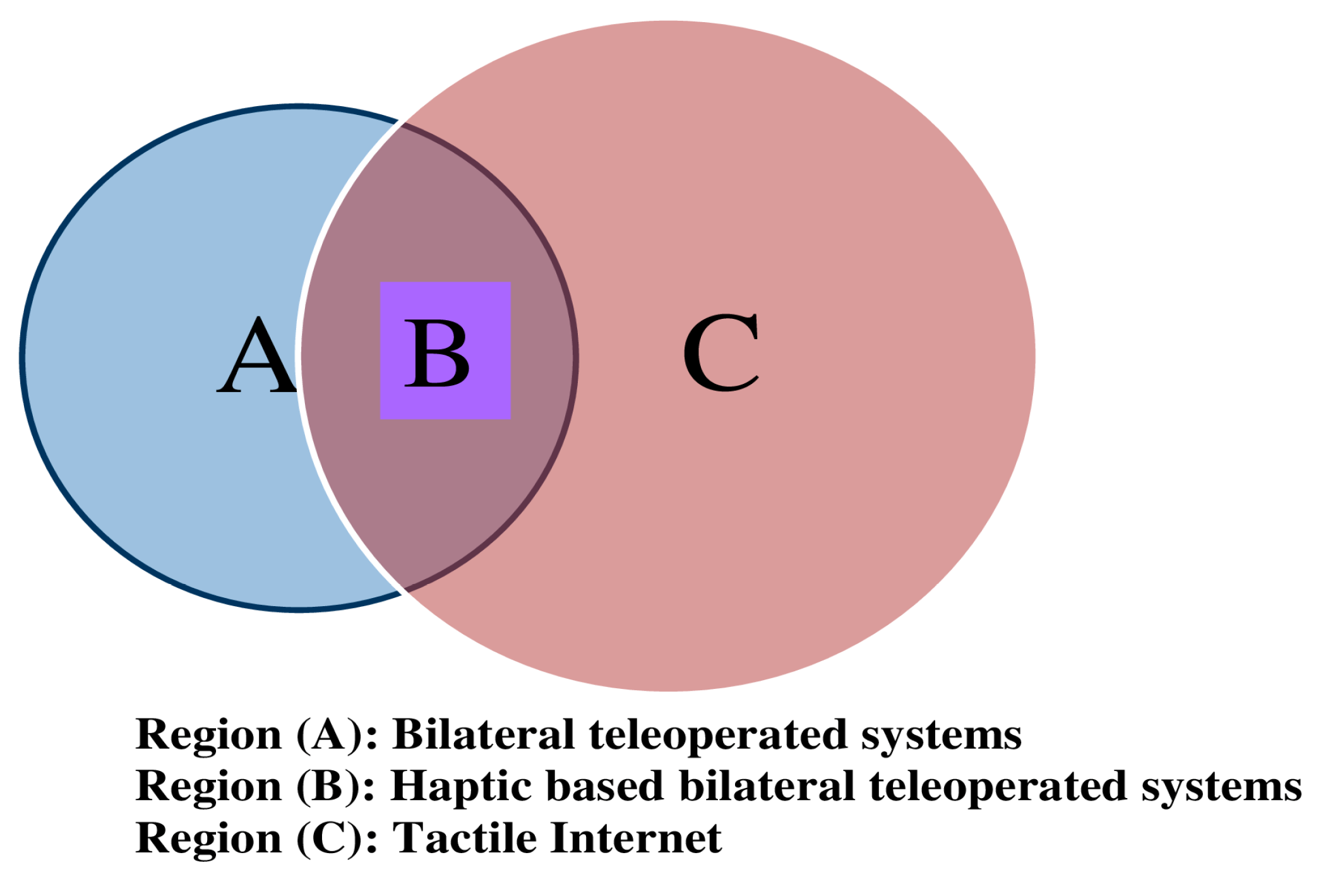
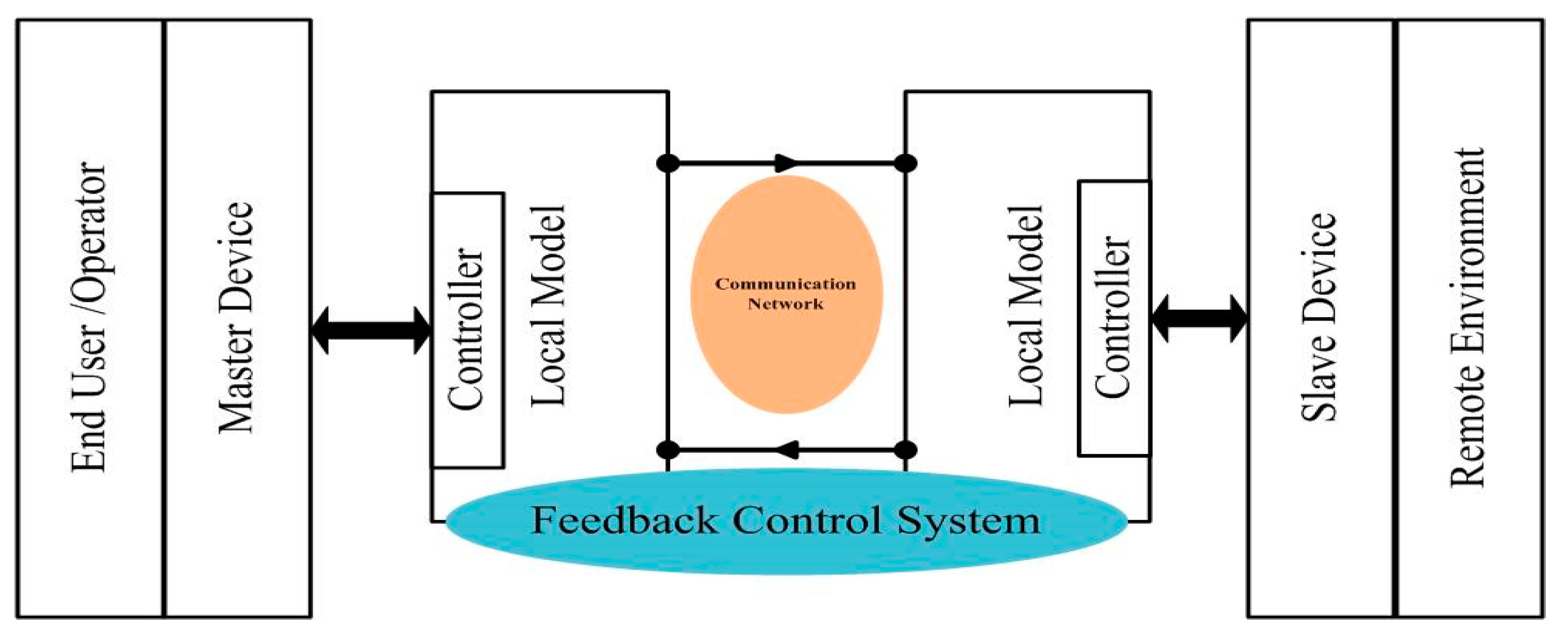
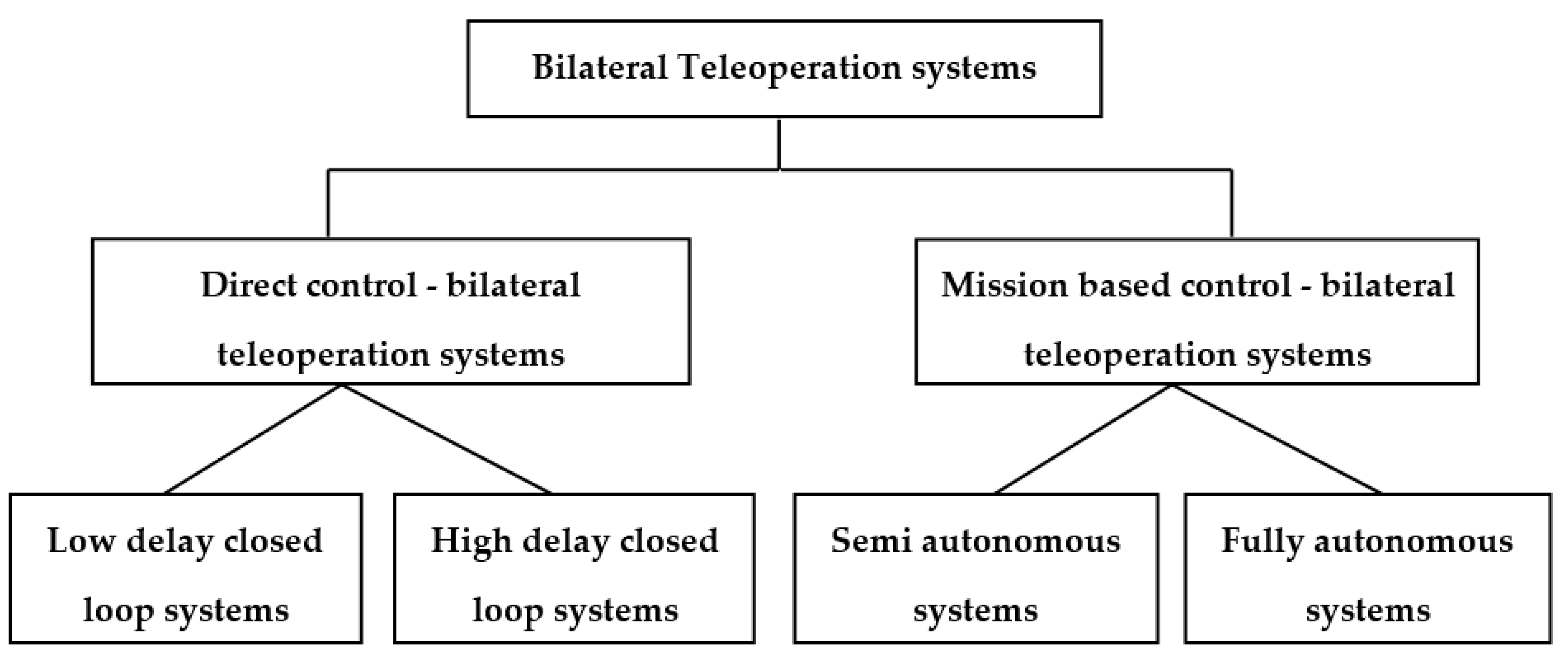
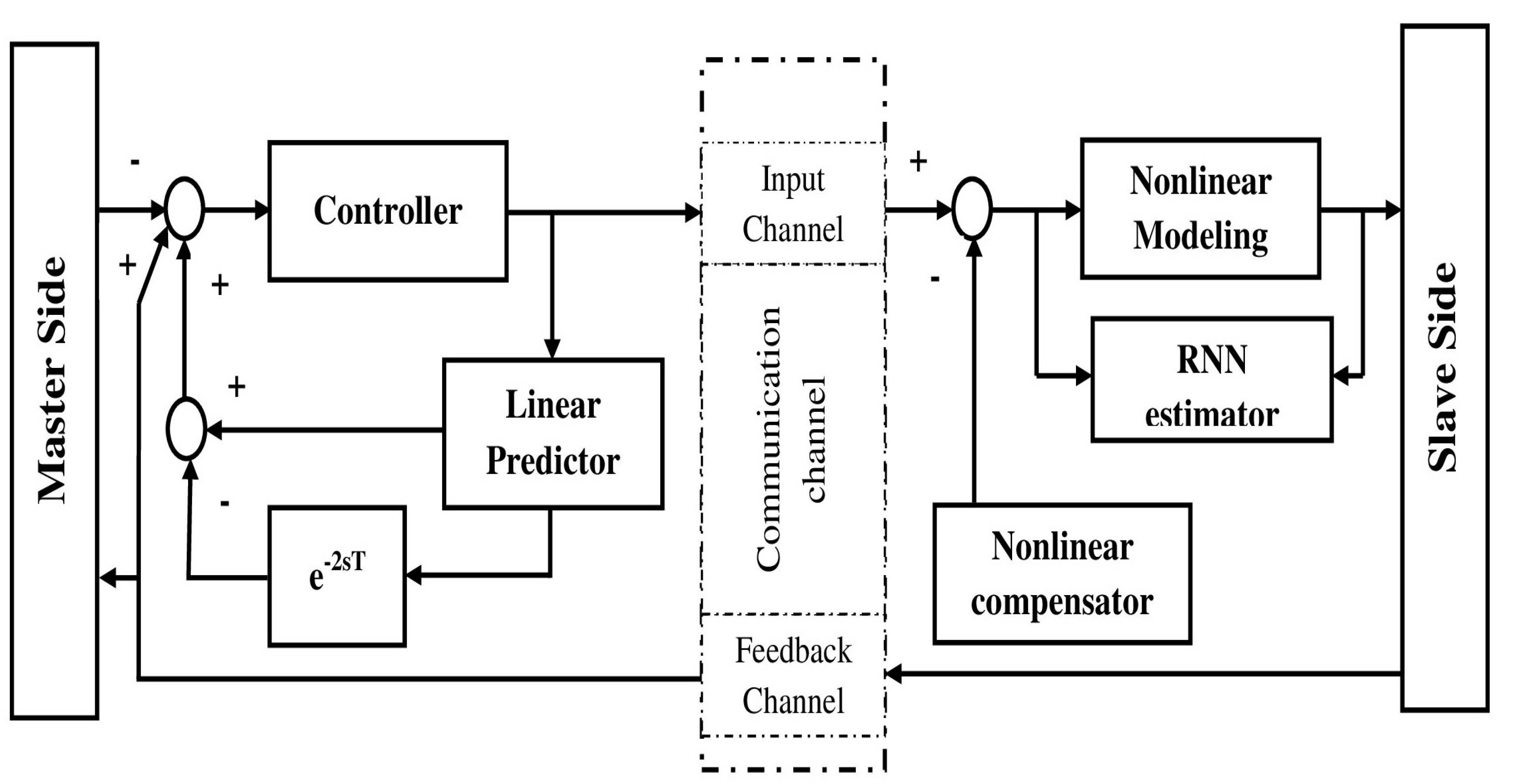
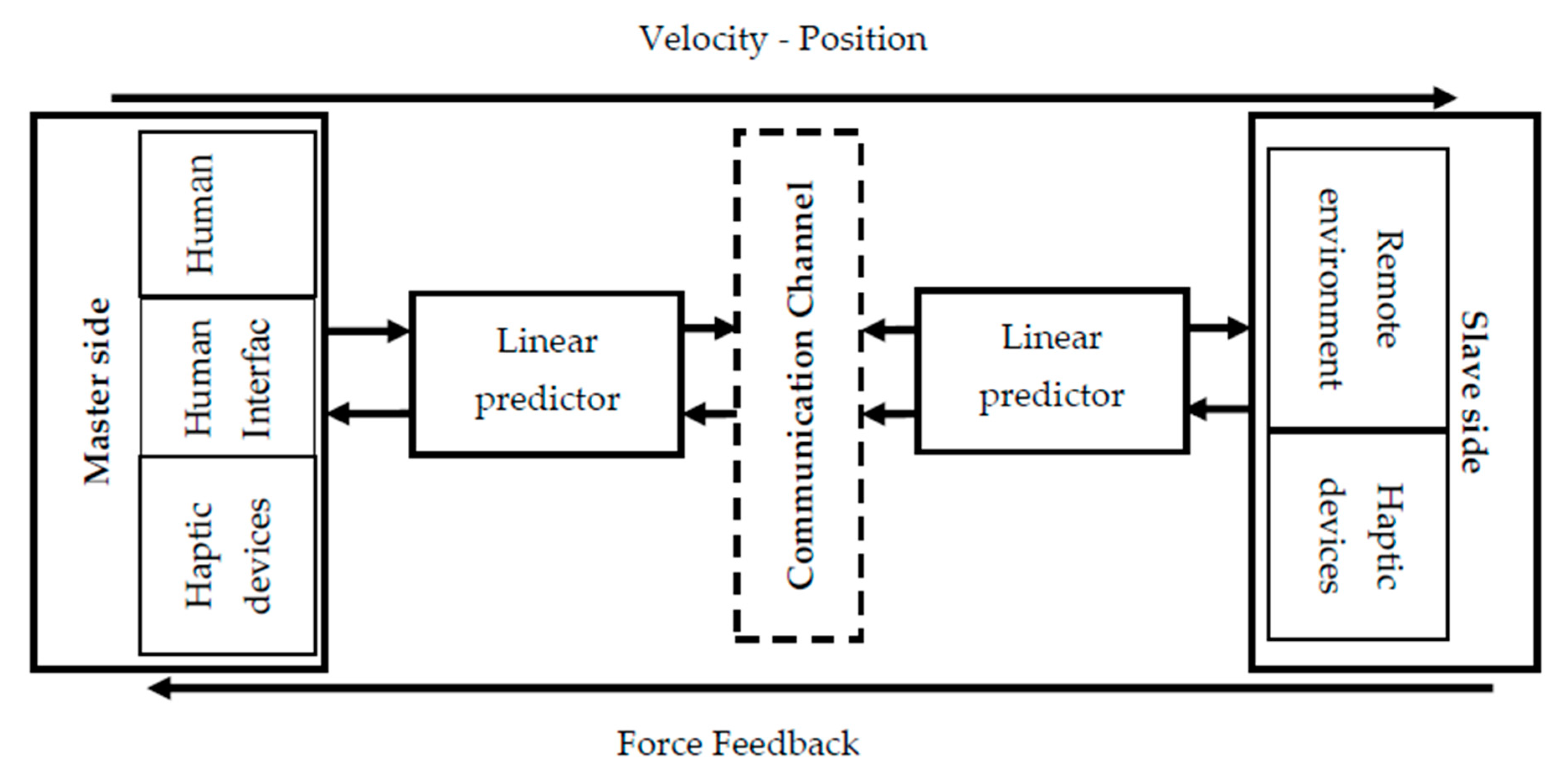
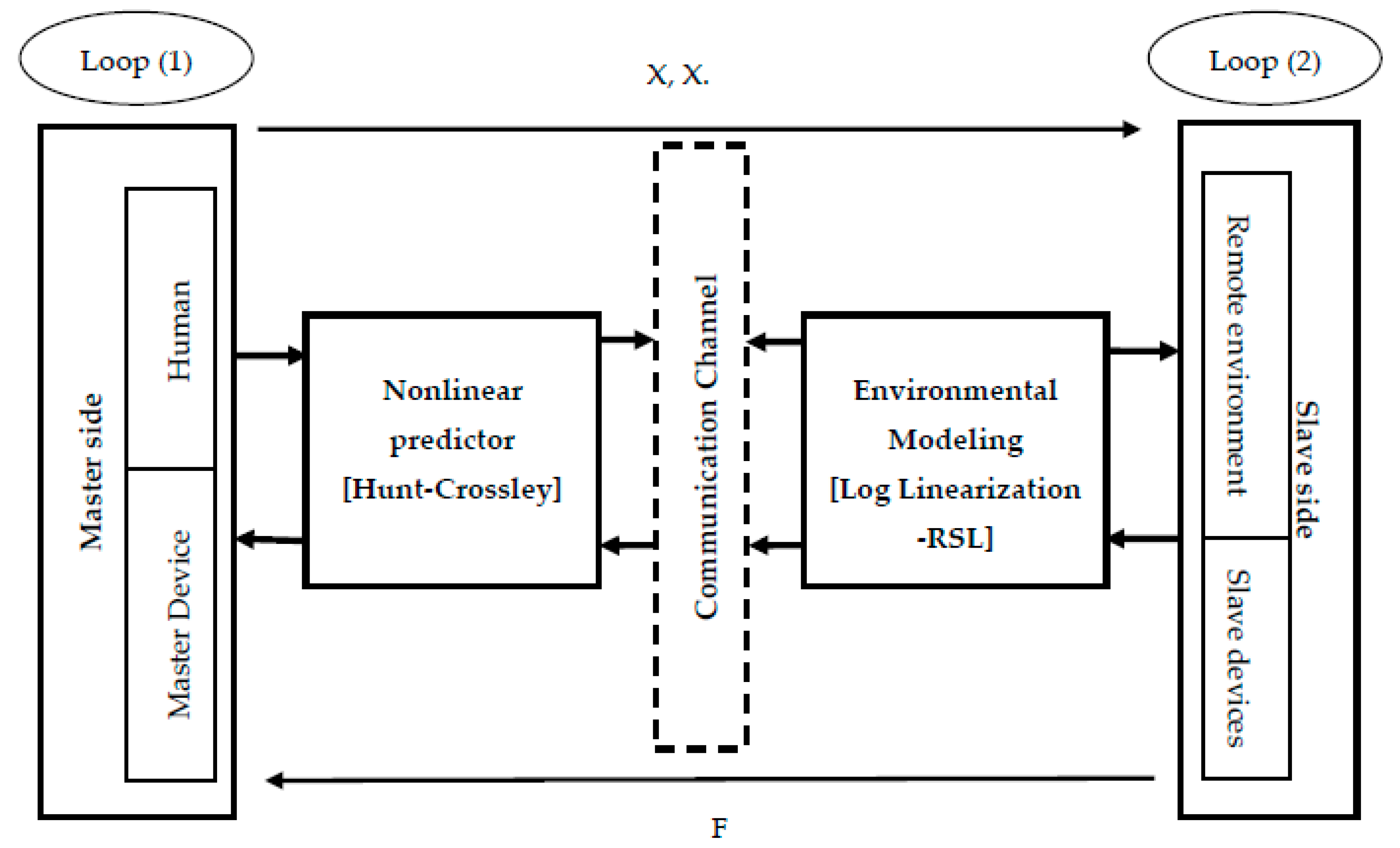
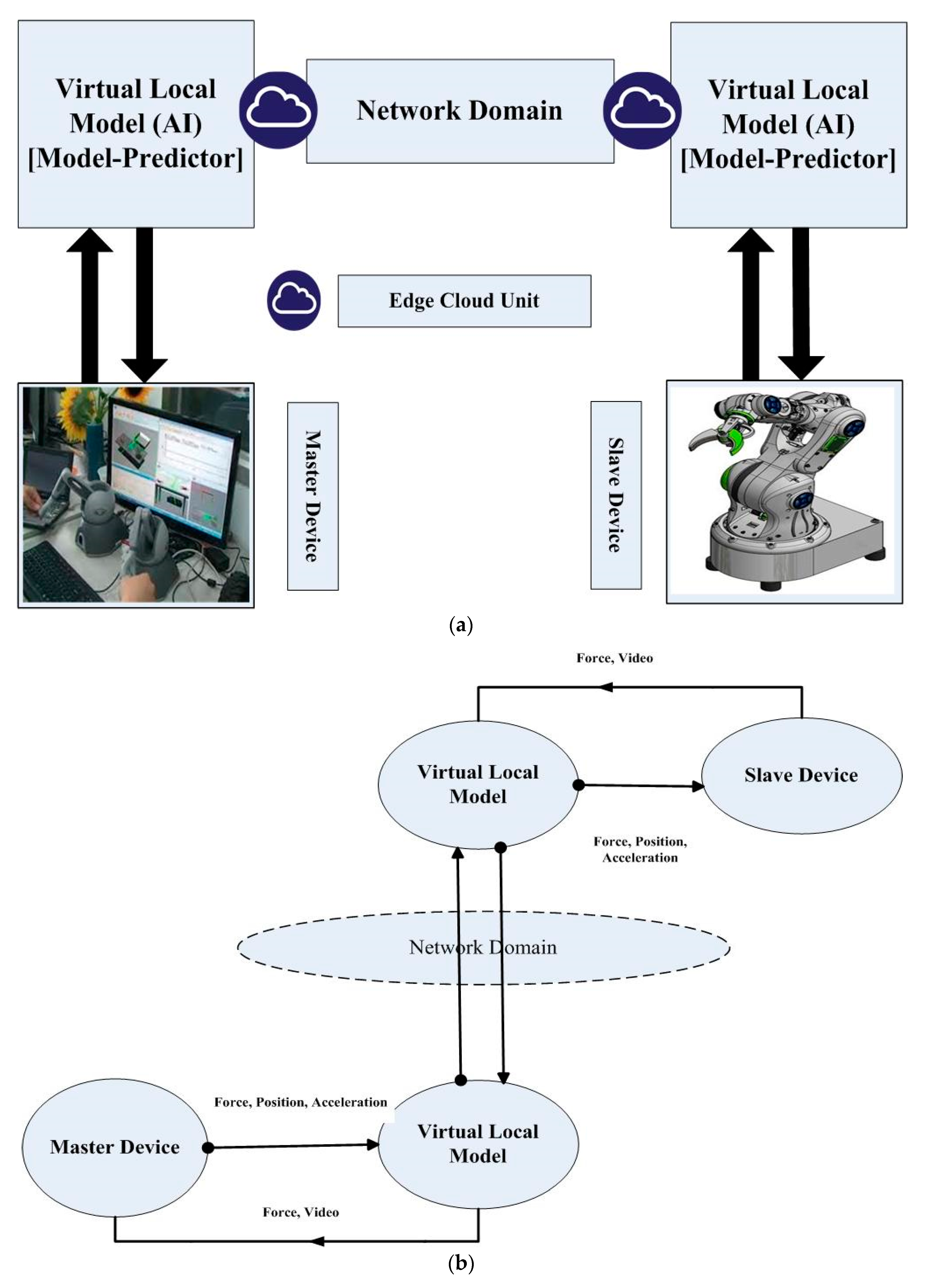
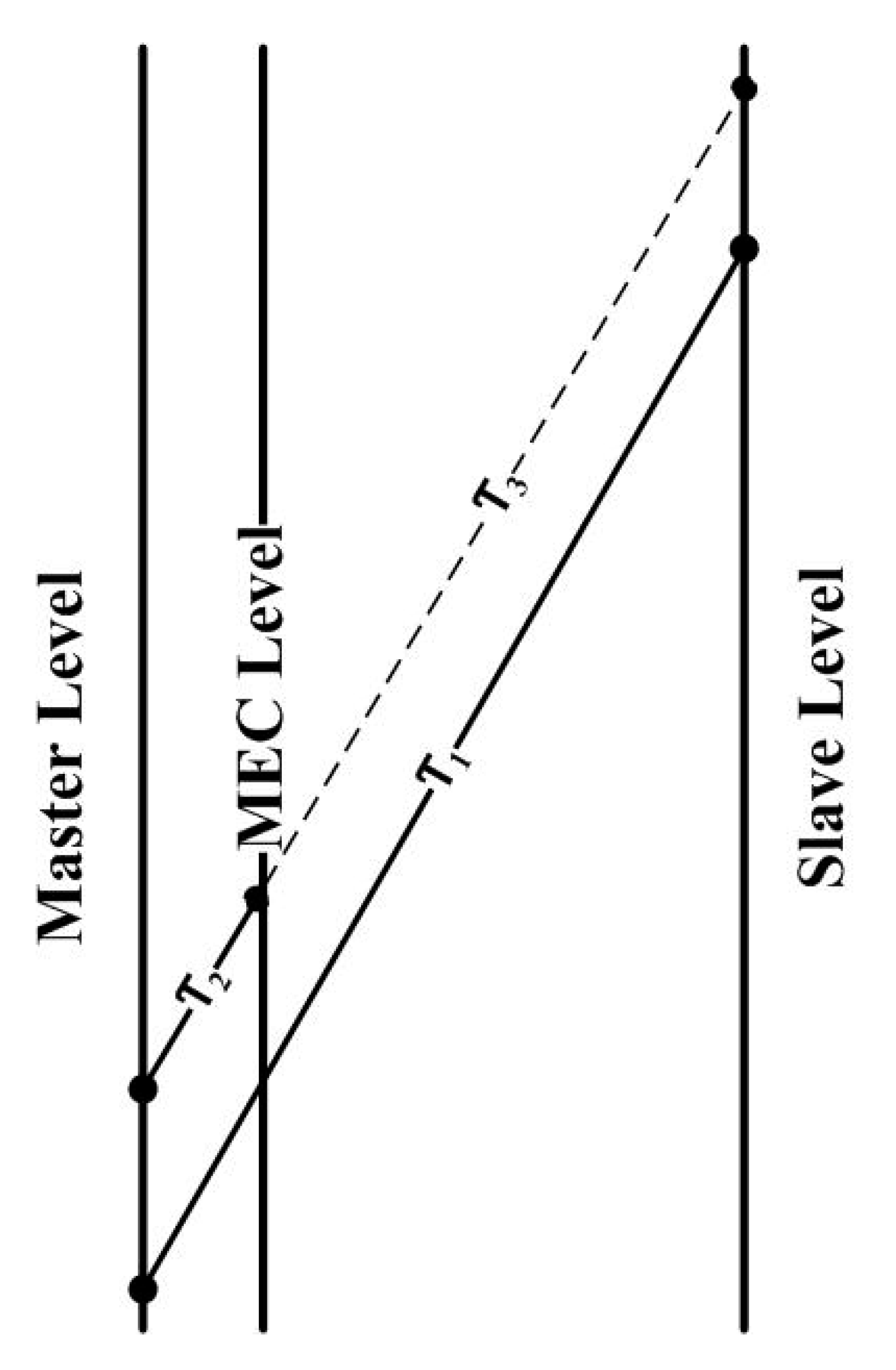
| Device | DoF | Maximum Force/Torque at Nominal Position | Stiffness X,Y,Z | Range of Motion | Characteristics | Applications |
|---|---|---|---|---|---|---|
| Touch [11]/ Geomagic Touch (Sensable Phantom Omni) [12] | 6 | 3.3 N | 1.26 N/mm 2.13 N/mm 1.02 N/mm | Hand movement pivoting at wrist | Positional sensing; Motorized device; High degree of flexibility with portable design; Compact footprint, removable stylus and two integrated buttons. | 3D modeling and manufacturing; Medical surgery and rehabilitation; Artwork and sculpting; Gaming, Entertainment, and Virtual Reality; Training, simulation processes, and skills assessment; Robotic control and teleoperation processes; Collision detection and virtual assembly; Machine interface design; Nano manipulation. |
| Phantom Premium (Sensable Phantom Premium) [13] | 6 | 8.5 N 37.5 N 22 N | 3.5 N/mm 3.5 N/mm 1 N/mm | Lower arm movement pivoting at elbow; Full arm movement pivoting at shoulder. | Provides the largest workspaces and highest forces; Offers a broad range of force feedback; Various ranges of motion and varying stiffness; Maximum durability and simple PC connection via the parallel port (EPP) interface. | Mainly developed for academic and commercial research and development. |
| Virtuose 6D [14] | 6 | 35N | 8 N/mm 30 N.m/rad | Full arm movement | High force feedback with a large workspace; Passive weight balancing; Available with programmable buttons and a proximity sensor. | Medical surgery and rehabilitation; Industrial simulation; training; Virtual reality |
| omega.7 [15] | 7 | 12 ± 8 N | 14.5 N/mm | Hand centered rotation | Designed for superior performance with no plastic components; Produces minimal user fatigue, due to active gravity compensation; Has a rotational sensing extension that is fully gravity compensated and designed to avoid interference from parasitic torques generated by translational forces; Simple and flexible; Provides high precision active grasping capabilities with orientation sensing. | Medical applications including remote surgery; Safety-critical applications; Training; Video gaming; Nanotechnology researches with the Atomic Force Microscopes; Micromanipulation. |
| sigma.7 [16] | 7 | 20 ± 8 N | unequal closed loop stiffness | Natural range of motion of the human hand; Compatible with bi-manual teleoperation console design. | High performance force-feedback; Highly ergonomic and distinctive design; High-fidelity torque feedback; Active gravity compensation; High precision active grasping capability; Designed for superior performance with no plastic components. | Advanced aerospace and medical industries; Safety-critical applications; Training; Developing of haptic applications. |
| Human Sense | Time Constant |
|---|---|
| Muscular interaction | 1 s |
| Auditory interaction | 100 ms |
| Visual interaction | 10 ms |
| Tactile interaction | 1 ms |
© 2019 by the authors. Licensee MDPI, Basel, Switzerland. This article is an open access article distributed under the terms and conditions of the Creative Commons Attribution (CC BY) license (http://creativecommons.org/licenses/by/4.0/).
Share and Cite
Ateya, A.A.; Muthanna, A.; Vybornova, A.; Gudkova, I.; Gaidamaka, Y.; Abuarqoub, A.; Algarni, A.D.; Koucheryavy, A. Model Mediation to Overcome Light Limitations—Toward a Secure Tactile Internet System. J. Sens. Actuator Netw. 2019, 8, 6. https://doi.org/10.3390/jsan8010006
Ateya AA, Muthanna A, Vybornova A, Gudkova I, Gaidamaka Y, Abuarqoub A, Algarni AD, Koucheryavy A. Model Mediation to Overcome Light Limitations—Toward a Secure Tactile Internet System. Journal of Sensor and Actuator Networks. 2019; 8(1):6. https://doi.org/10.3390/jsan8010006
Chicago/Turabian StyleAteya, Abdelhamied A., Ammar Muthanna, Anastasia Vybornova, Irina Gudkova, Yuliya Gaidamaka, Abdelrahman Abuarqoub, Abeer D. Algarni, and Andrey Koucheryavy. 2019. "Model Mediation to Overcome Light Limitations—Toward a Secure Tactile Internet System" Journal of Sensor and Actuator Networks 8, no. 1: 6. https://doi.org/10.3390/jsan8010006
APA StyleAteya, A. A., Muthanna, A., Vybornova, A., Gudkova, I., Gaidamaka, Y., Abuarqoub, A., Algarni, A. D., & Koucheryavy, A. (2019). Model Mediation to Overcome Light Limitations—Toward a Secure Tactile Internet System. Journal of Sensor and Actuator Networks, 8(1), 6. https://doi.org/10.3390/jsan8010006








